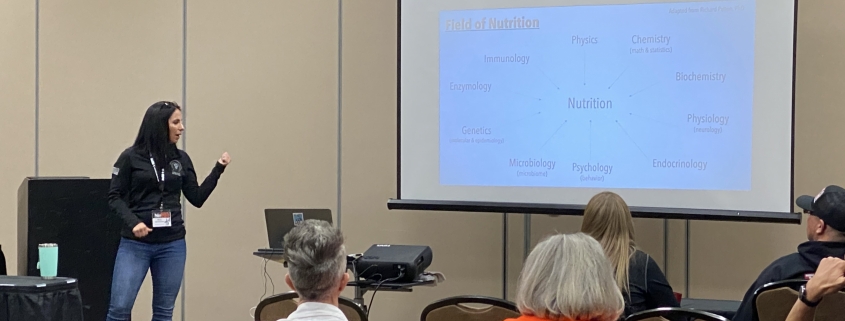Summary
Background
If you’ve been keeping up with the news or browsing social media, you may have come across claims that certain pet foods, especially grain-free ones, can cause heart disease in dogs. However, the latest report from the FDA tells a different story, revealing a complex issue with no scientific evidence proving a causal link between grain-free diets and heart disease.
It’s crucial to understand that this issue is not straightforward, and there are multiple factors at play. Before delving into the FDA investigation and the possible association between heart disease and grain-free foods, it’s essential to address what the news media failed to do. In short, while the media has been quick to blame grain-free pet foods for heart disease in dogs, the reality is far more nuanced.[1] The FDA report is based on a limited sample size, and the agency itself admits that there is no clear evidence linking grain-free diets to heart disease. Therefore, it’s important to consider all the relevant factors before jumping to conclusions. By taking a closer look at the FDA investigation and the scientific evidence, pet owners can make informed decisions about what to feed their pets.
Before examining the FDA investigation and the facts surrounding a potential association between heart disease and grain-free foods it is important to address what the news media failed to do:
Over half of American dogs are overweight2, diabetes rates are rising faster than we can measure and cancer is becoming more prevalent not just in the old, but in the young3. Also common are kidney disease4 and liver disease5 and dogs and cats experiencing more food and environmental sensitivities and allergies than we have ever seen6. Diet-mediated dilated cardiomyopathy (DCM) has affected a relatively small number of dogs from 2014 to date, approximately 524 out of an estimated 77 million dogs in the United States – as of the latest FDA report7. While this is certainly a concern that warrants further investigation in a timely manner – DCM is not by any means an epidemic. In fact, the FDA states that they believe the potential association between diet and DCM in dogs is a complex scientific issue that may involve multiple factors7.
Few Pets are Healthy
In examining the whole picture, we know that dogs and cats are not “healthy” – a reality that most of us either ignore or don’t believe to be true. Common problems like skin conditions, “dog-smell”, and GI issues are not – and should not be considered healthy; even though we’ve come to accept them as normal. Some of the causality behind “common” problems is that our pets have been, and still are, subject to many detrimental variables over generations and the consequences of such have impacted the overall wellbeing and susceptibility of varying types of disease. These variables include, but are not limited to: toxins and pollution in the air, water, soil and food supply, overuse of antibiotics and other medication, overvaccination, poor quality diet, poor breeding practices, poor nutrition, lack of exercise and radiation. It is possible that some, or more likely, each of these factors have contributed to our pet’s susceptibility to a variety of diseases, including DCM. In fact, obesity, diabetes and other issues have known relationships to DCM8 – all factors that complicate the scientific investigation.
Understanding Risk Factors
The good news is that just because an individual is “predisposed” to a particular disease does not mean that they are going to “develop” that disease9 as the expression of a “bad gene” can be altered by a healthful diet and limiting exposure to toxins and stress. Alternatively, if dogs or cats are constantly exposed to various toxins, fed a diet lacking vital nutrition, moisture and meat protein, over-vaccinated, overmedicated and deprived of exercise and are obese much like how they have been for generations, they have a significant risk10 of developing the disease to which they are predisposed to. This newer field of science, referred to as nutrigenomics, studies the nutrient impact on gene expression and nutritional influences on the Genome, Transcriptome, Proteome, and Metabolome and extract useful biological information on the data collected. This field has melded practices from Nutrition, Biology, Medicine, Genomics, and Bioinformation11.
Let’s imagine for a second that an individual was predisposed to heart disease, but they took care of themselves by consuming a diet consisting of fresh foods, including antioxidants along with moderate fat, and sodium, avoided excess use of vaccinations, limited unnecessary medications, consumed clean water and exercised to maintain strong cardiac function. These individuals most likely have a lesser chance of developing heart disease. For the sake of not oversimplifying this concept, a healthy lifestyle for us or our pets does not eliminate the risk of disease, but it does make our genes more resilient, or resistant to letting that disease develop or advance. In 2005, the Broad Institute began mapping the canine genome, which allows us to further explore what genetic markers are related to specific diseases. This mapping project will not only help us to identify targeted pharmaceutical and nutritional therapies that may help in treatment for prevention but also help to advance knowledge, treatment, and prevention of diseases for humans12.
consisting of fresh foods, including antioxidants along with moderate fat, and sodium, avoided excess use of vaccinations, limited unnecessary medications, consumed clean water and exercised to maintain strong cardiac function. These individuals most likely have a lesser chance of developing heart disease. For the sake of not oversimplifying this concept, a healthy lifestyle for us or our pets does not eliminate the risk of disease, but it does make our genes more resilient, or resistant to letting that disease develop or advance. In 2005, the Broad Institute began mapping the canine genome, which allows us to further explore what genetic markers are related to specific diseases. This mapping project will not only help us to identify targeted pharmaceutical and nutritional therapies that may help in treatment for prevention but also help to advance knowledge, treatment, and prevention of diseases for humans12.
FDA Investigation & Reports
The FDA formally announced an investigation into grain-free dog foods potentially having a link to heart disease in dogs in July of 2018. The investigation specifically named those foods containing potatoes, legumes and pulses7. Pulses are a subset of legumes and are defined as peas, lentils, chickpeas and other dry beans13. Since there is no central reporting agency for canine disease the FDA states that it is unknown how commonly dogs develop Dilated Cardiomyopathy. However, the increase in reports to the FDA may indicate a potential increase in canine DCM in breeds not previously known to be predisposed7 and it is unclear if cases have been underreported, and continue to be underreported or if there is a significant spike in cases as a result of these diets, or multiple other variables. Dilated Cardiomyopathy (DCM) is defined as a condition where the heart becomes enlarged and is unable to adequately pump blood. DCM can include mechanical dysfunction and/or electrical dysfunction which leads to sudden collapse and death13. As DCM progresses signs include lethargy, loss of appetite, shallow breathing, intolerance to exercise and shortness of breath. This disease is known to occur in dogs and cats, at varying levels of severity and has more than one cause14.
Further complicating matters DCM has causation that is likely multivariable such as genetics, environmental, nutritional, infections, heavy metal exposure, dysbiosis, and even other unknown causes14,15. Further commentary articles, not research articles, from experts examining the issue seemed to state that there is no direct evidence showing causation between DCM and grain-free pet foods – and that it will take several years to determine what the issue or issues are. The most recent FDA report explicitly states they are investigating and gathering more information in an effort to identify whether there is a specific dietary link to the development of DCM, and based on the data collected thus far, they believe the development of DCM is a complex scientific issue that may involve multiple factors. As a result, the major pet food brands have jumped at the opportunity to sow a seed of doubt in to the minds of pet parents leading some to make unnecessary, and even health prohibiting changes.
Not Just Grain-Free Diets
It is important to note – out of some dogs diagnosed with DCM, not all dogs were consuming a grain-free diet1. Even more notable, most dogs were eating dry food in those cases reported to the FDA1, which raises the question of this not being a grain-free problem per se – instead rather evidence of a knowledge gap in formulation of processed food. As the report notes, some improved after a diet change from one grain-free diet to another, and this finding, along with the differences identified between dogs fed various grain-free diets, suggested that DCM was not necessarily tied to the grain-free status of the diet13,16. In addition, many dogs diagnosed with DCM were initially thought to be taurine-deficient, and we’ve since learned that this problem is far more complex than the presence or digestibility of taurine within a dry pet food. We’re now realizing the presence of significant knowledge gaps in regards to small animal nutrition requirements – plainly, we do not know enough about what happens to food when we process it beyond a recognizable state.
Nutritional Knowledge Gap
The formulation of static diets is formulated from generalized minimal recommendations by the Association of American Feed Control Officials (AAFCO) and the NRC which are wholly lacking in sound and reasonable research. Static diets are defined as a diet that a dog may eat each day, for their entire life, and that food providing all the nutrition they need. These minimum nutrient recommendations have been established with research on Beagles as a proxy for all canines regardless of size or breed13. These same recommendations also place pregnant bitches in the same category as growing animals – even though we know that nutritional requirements are different. Additionally, recommendations made by AAFCO correspond to a total nutrient content within the formulation and do not consider the true digestibility of ingredients leading to the potential of a variety of nutrient deficiencies across multiple breeds17. Available research demonstrates that the taurine, methionine, cystine, carnitine and other nutrient metabolism is varied among sizes and breeds13, all of which are variables further complicating this investigation.
Some within the veterinary community have illogically lumped home cooked, canned and raw diets into the “grain free” category, however, per the FDA report, the vast majority of DCM cases were reported were for dogs consuming dry foods1 – not “grain-free” raw or “grain-free” cans, causing unnecessary panic at the expense of pet owners feeding responsibly formulated and safely sourced canned and raw foods. It is important for the consumer and pet-owner to understand that these diets are entirely different in formulation, composition and differ in the way they are formulated and metabolized in comparison to overly-processed dry diets. Fresh and unprocessed diets, like raw, will have abundant taurine and natural nutrients which can limit risks of malabsorption and nutrient deficiencies that are common in kibble and other processed diets. Oversimplifying this issue to “grain-free” raw, canned and home-cooked diets is irresponsible and likely causing more harm than good.
DCM is not a ‘new’ concern for dogs or cats. In fact, it has been around for a long time. In the 1970’s -1980’s DCM was prevalent in cats and it was eventually determined that this was due to low concentrations of taurine and animal protein within the commercialized foods18. Pet food companies responded by adding taurine through supplementation and additional meat protein which has since seemed to remedy this issue19, however it leaves many other concerns unanswered. The supplementation of nutrients and addition of processed meat is still not an ideal example of adequate nutrition and another example of overly processed diets contributing to the overwhelming amount of disease in companion animals.
Since dogs and cats are nutritionally different it is unlikely that adding taurine to any canine diet will be sufficient to solve the current issue in dogs, especially since diet-related canine DCM is likely far more complex. Further complicating matters, the only definitive diagnosis for DCM is an echocardiogram, which the majority of “cases” highlighted within the FDA report lack. Other methods of screening for potential cardiac disease are whole blood taurine, plasma taurine, auscultation, and chest x-ray it is important to understand that these methods are not reliable in the diagnosis of DCM.
More information here.
Complicated Variables
We know that certain breeds are genetically predisposed to DCM and those include (but are not limited to) Doberman Pinschers, Boxers, Great Danes, Labrador Retrievers, St. Bernards, Irish Wolfhounds, Golden Retrievers, Newfoundlands, English, and American Cocker Spaniels18,20. There is no cure for genetic DCM, and conventional veterinary treatment involves the use of diuretics, ACE inhibitors, antiarrhythmic, and other pharmaceutical agents to reduce stress on the cardiopulmonary system and kidneys to allow the body to tolerate the condition. Unfortunately, these options provide limited relief for a generally short period of time21.
DCM can also be closely related to diet, meaning that an individual’s susceptibility can be influenced by diet imbalance. Initially, the assumption with current DCM concerns was a lack of taurine in the diet for varying reasons. However, it was determined that this was likely not true for most cases7 and instead researchers are now considering other factors preventing the body from utilizing taurine and other nutrients – while also keeping in mind that the issue may be something else entirely. Another theory is that one or more ingredients are interacting with others causing a blocking effect on taurine utilization. The truth is that researchers are unsure exactly what the mechanism behind this condition is19.
Disproportionate Levels of Macronutrients
DCM aside, all dry foods that have a high carbohydrate content of at least 30% (grain AND grain-free) can be a problem for several reasons that most haven’t recognized:
- Ingredients such as potatoes, peas, and other legumes and pulses have been used in grain-inclusive and grain-free dog food for nearly 25 years22,23 to provide dietary fiber and protein in limited capacity. It is recognized that use of some of these ingredients at higher than 15% inclusion on a dry matter basis can decrease crude protein digestibility. Since some foods on the market have greater than 40%, and even up to 60%, inclusion this could facilitate higher risk of nutritional deficiencies if nutrient balance is not considered in the formulation13. This can also yield inadequate amount of animal protein which may lead to an imbalance or not enough of various nutrients – one of which can be taurine, and too little taurine (taurine deficiency) can result in DCM.
- Some plant-based proteins, like pea or potato protein, can cause malabsorption and inflammatory conditions in humans24. While insufficient research is available to suggest the same in pets, it is certainly a reasonable theory to explore. More and more institutions are exploring the similarities in humans and canines12,25–27 and while some still refute the similarities, the stark similarities in types and rates of disease are unquestionable. Logically, these similarities are not surprising considering that by and large humans eat a highly-processed diet full of chemicals, lack exercise, overuse of medication, and live exposed to environmental toxins and pollution, just like their pets.
Before assigning blame to a particular ingredient, set of ingredients or formulation it is prudent first to identify knowledge gaps – especially prior to establishing any causation to a particular disease. Further investigation into these inclusion percentages and relationship to canine health and risk factors is needed to understand these relationships13. It is known that grains contain precursors to taurine – amino acids cysteine and methionine. Dogs can manufacture taurine from these amino acids, and it was always thought that taurine was not essential for canines – however individual genetics, breed, size and environmental factors may alter an individual minimum and maximum requirements for taurine and other nutrients13.
Grain Complications
The pet food industry switch to grains was not exactly fueled by a problem with the actual grains, or grain allergies like most believe. Absent from the discussion on grain-free vs. grain inclusive diets for people – and pets – is the contamination of grains with herbicides, pesticides, mycotoxins, and fertilizers. There are numerous peer-reviewed articles detailing the disruption many of these contaminants have on normal gut bacteria function28,29 and these are the largest reasons more animals and humans are becoming increasingly intolerant to grain and grain products. We’re learning that disruption of vital gut bacteria balance can have devastating effects on the health of the host30,31, including diabetes, obesity, autoimmune disease, cancers, GI issues and even DCM32. The contamination of grains in pet food is likely why many pets experienced improvement of various symptoms with the change from grain-inclusive to grain-free.
Pet food can be made of everything from rendered unfit foods for human consumption to ingredients that are 100% organic and probably better than the food we feed ourselves. I’m not necessarily here to split hairs on ingredients and in the types of ingredients that are in our pet’s food. Because is it these ingredients that are causing the problem? Or is it something else? – These are the questions that the experts seem to avoid entirely. When a dog experiences issues related to food we are quick as a society to turn over the bag and blame an ingredient or set of ingredients. However, those ingredients as listed are likely not the problem – rather the quality, processing, and contamination of these ingredients; something you will never find listed on a label.
Pet Food Processing & Chemical Factors
Protein, fat, and carbohydrates go through irreversible denaturation with the heating process of making kibble. Kibble is heated to high temps which creates a chemical change. A Maillard Reaction Product (MRP) is the name for a series of reactions that is the product of sugar (or carbohydrate) and protein when heated. These are also known as AGE’s or Advanced Glycated End Products. MRP’s are responsible for nutrient loss and associated with diseases like diabetes25, cardiovascular disease33,34, kidney disease34, loss of cognitive function34,35, allergies36, periodontal disease37, and chronic inflammation38. This can mean things like arthritis, skin and ear issues, an old injury that keeps resurfacing, bloating, IBS, etc. In addition, there is a large amount of research to suggest that they are carcinogenic and accelerate aging38,39.
Heterocyclic amines are MRPs from cooking protein that increases with elevated cooking temperature. This phenomenon is more pronounced in meat than fish – and these increase with temperature and dryness of meat or meat products40.
Acrylamides are a chemical that forms naturally from starchy foods during high-temperature cooking. According to the European Food Safety Authority evidence from animal studies shows that Acrylamides are genotoxic and carcinogenic: they damage DNA and cause cancer. And since we know so little about animal nutrition is it possible that much of the disease we’re seeing – including DCM has at least something to do with the MRP’s that are in pet food?
The process of making kibble can be responsible for a dog’s inability to tolerate certain foods in processed form, and for the incidence of certain diseases. It also explains why some dogs are able to tolerate and even thrive when these foods are fresh instead of processed. We do not have enough research that fully explains what happens to food when it is processed beyond a recognizable state. Nor do we have enough epidemiological studies to understand the consequences of feeding processed food diets for generations. Unfortunately, what we do know is that DCM is not the only problem that will arise as a consequence of feeding a highly-processed diet. There will be potentially more severe and prevalent conditions that will arise.
How to Mitigate Risk
Please recognize that this does not mean that you must feed all fresh food – or all kibble. Theory always suggested that mixing fresh food and kibble would result in GI distress or cause problems over time. Fortunately, that theory no longer holds much weight. Rather, feeding vegetables and fruit that are high in antioxidants with kibble provide protective effects against MRP’s. In addition, feeding raw or cooked meat along with kibble provides amino acids, vitamins, and minerals in their most natural form. While research is in the works and isn’t yet published, researchers are finding that feeding raw and kibble together actually reduced inflammatory markers for certain diseases, when done properly. There is also a notable but non-peer reviewed case-study of a dog successfully fed fresh food and kibble which suggested that kibble may have digested at the same rate or slightly faster than raw41.
Regardless of what method you choose to feed, feeding fresh food does not only mean raw or cooked meat. Fresh food such as vegetables and fruit can provide some antioxidant protection against MRP’s, provide additional phytonutrients in their most natural form and improve digestive function. In addition, consumption of green, yellow and cruciferous vegetables reduces oxidative stress which can lead to lower incidence of certain cancers, cardiovascular disease, promote liver detoxification, reduce inflammation and positively impact the function of the immune system42.
Closing Discussion
The considerations surrounding DCM challenges are extremely complicated, with many unknowns. It will likely be many years before any formal answers are reached. Currently, there are no formal dietary recommendations for pet owners from the FDA as of the latest report. If your dog is in a risk group (breed, genetic or other underlying condition) it is best to seek advice from your veterinarian on the health status of your pet. Some experts are recommending adding taurine to pets’ diets regardless of what you feed19. Adding taurine can be as simple as purchasing a taurine supplement from a trusted source. Consideration of fresh foods is advised, since taurine naturally occurs in animal products – not grains – adding items like chicken breast, beef or other animal heart, sardines, raw goat milk, and other animal products may be beneficial.
Moving from grain-free kibble to grain-in kibble is not likely to solve health, longevity or other nutritional challenges as both of these groups are ultra-processed foods that carry well-documented risks highlighted within this paper. Our canines are largely suffering from man-made diseases and conditions such as obesity, type II diabetes, and nutritional deficiency – among others. Most of these can be linked back to feeding low-moisture, high soluble carbohydrate, low meat protein and ultra-processed dry food with high levels of contaminants. While there is a knowledge gap in the nutrition of both ultra-processed and raw, one cannot deny the association between ultra-processed foods and disease prevalence, and progression. It is also evident that feeding fresh foods provide at least some reduced risk of these common diseases and conditions.
It is imperative to understand and practice methods that recognize each individual animal as different, having unique needs. Not any one diet is complete – and no feeding regimen will be successful for all pets and this very practice is what has been detrimental to our pets and brought us to this point. As always, all diet changes and additions should always be introduced slowly and carefully. It is always helpful to keep a food journal that can help experts determine potential foods or feeding patterns that may be problematic.
*This article is for informational purposes only. It is not meant to provide medical advice or replace the advice of a qualified veterinarian. If you think your pet has DCM, or any medical condition please seek the advice of a qualified veterinarian.
1.Medicine C for V. FDA Investigation into Potential Link between Certain Diets and Canine Dilated Cardiomyopathy. FDA. June 2019. https://www.fda.gov/animal-veterinary/news-events/fda-investigation-potential-link-between-certain-diets-and-canine-dilated-cardiomyopathy. Accessed June 29, 2019.
2. Obesity in pets | AAHA. https://www.aaha.org/pet_owner/lifestyle/obesity-in-pets.aspx. Accessed May 15, 2019.
3. Cancer in Pets. https://www.avma.org/public/PetCare/Pages/Cancer-in-Pets.aspx. Accessed May 15, 2019.
4. Langston CE. Chapter 136â”Chronic Renal Failure. In: Silverstein DC, Hopper K, eds. Small Animal Critical Care Medicine. Saint Louis: W.B. Saunders; 2009:594-598. doi:10.1016/B978-1-4160-2591-7.10136-5
5. Bexfield NH, Buxton RJ, Vicek TJ, et al. Breed, age and gender distribution of dogs with chronic hepatitis in the United Kingdom. Vet J Lond Engl 1997. 2012;193(1):124-128. doi:10.1016/j.tvjl.2011.11.024
6. Marsella R, De Benedetto A. Atopic Dermatitis in Animals and People: An Update and Comparative Review. Vet Sci. 2017;4(3). doi:10.3390/vetsci4030037
7. Medicine C for V. FDA Investigating Potential Connection Between Diet and Cases of Canine Heart Disease. FDA. February 2019. /animal-veterinary/cvm-updates/fda-investigating-potential-connection-between-diet-and-cases-canine-heart-disease. Accessed May 15, 2019.
8. Alpert MA. Obesity Cardiomyopathy: Pathophysiology and Evolution of the Clinical Syndrome. Am J Med Sci. 2001;321(4):225-236. doi:10.1097/00000441-200104000-00003
9. Hunter P. We are what we eat. The link between diet, evolution and non-genetic inheritance. EMBO Rep. 2008;9(5):413-415. doi:10.1038/embor.2008.61
10. Berenson GS, Srinivasan SR. Emergence of Obesity and Cardiovascular Risk for Coronary Artery Disease: The Bogalusa Heart Study. Prev Cardiol. 2001;4(3):116-121. doi:10.1111/j.1520-037X.2001.00537.x
11. Sales NMR, Pelegrini PB, Goersch MC. Nutrigenomics: Definitions and Advances of This New Science. Journal of Nutrition and Metabolism. doi:10.1155/2014/202759
12. Dog Disease Mapping Project (DogDNA). Broad Institute. https://www.broadinstitute.org/project-spotlight/dog-disease-mapping-project-dogdna. Published June 9, 2011. Accessed May 15, 2019.
13. Mansilla WD, Marinangeli CPF, Ekenstedt KJ, et al. Special topic: The association between pulse ingredients and canine dilated cardiomyopathy: addressing the knowledge gaps before establishing causation. J Anim Sci. 2019;97(3):983-997. doi:10.1093/jas/sky488
14. Canine Dilated Cardiomyopathy (DCM). Cornell University College of Veterinary Medicine. https://www.vet.cornell.edu/hospitals/companion-animal-hospital/cardiology/canine-dilated-cardiomyopathy-dcm. Published December 13, 2017. Accessed May 15, 2019.
15. Dilated Cardiomyopathy in Dogs. https://www.vetmed.wsu.edu/outreach/Pet-Health-Topics/categories/diseases/dilated-cardiomyopathy-in-dogs. Accessed May 15, 2019.
16. Freeman LM, Stern JA, Fries R, Adin DB, Rush JE. Diet-associated dilated cardiomyopathy in dogs: What do we know? J Am Vet Med Assoc. 2018;253(11):1390-1394. doi:10.2460/javma.253.11.1390
17. Columbus D, de Lange CFM. Evidence for validity of ileal digestibility coefficients in monogastrics. Br J Nutr. 2012;108 Suppl 2:S264-272. doi:10.1017/S0007114512002334
18. Pion PD, Kittleson MD, Thomas WP, Skiles ML, Rogers QR. Clinical findings in cats with dilated cardiomyopathy and relationship of findings to taurine deficiency. J Am Vet Med Assoc. 1992;201(2):267-274.
19. DCM: add taurine to grain-free dog foods, say scientists | PetfoodIndustry.com. https://www.petfoodindustry.com/articles/8162-dcm-add-taurine-to-grain-free-dog-foods-say-scientists?v=preview. Accessed May 15, 2019.
20. DACVIM CDSBM. Breed-specific variations of cardiomyopathy in dogs. Dvm360.com. https://veterinarynews.dvm360.com/breed-specific-variations-cardiomyopathy-dogs. Accessed May 15, 2019.
21. Dilated Cardiomyopathy in Dogs. Vca_corporate. vcahospitals.com/know-your-pet/dilated-cardiomyopathy-dcm-in-dogs–indepth. Accessed May 15, 2019.
22. Butterwick R, J Markwell P, J Thorne C. Effect of Level and Source of Dietary Fiber on Food Intake in the Dog. J Nutr. 1995;124:2695S-2700S. doi:10.1093/jn/124.suppl_12.2695S
23. Rice JE, Ihle SL. Effects of diet on fecal occult blood testing in healthy dogs. Can J Vet Res Rev Can Rech Veterinaire. 1994;58(2):134-137.
24. Freed DLJ. Do dietary lectins cause disease? BMJ. 1999;318(7190):1023-1024.
25. Research by DogRisk. University of Helsinki. https://www.helsinki.fi/en/researchgroups/dogrisk-health-via-nutrition-epidemiology-and-cancer-detection-dogs/research-by-dogrisk. Published June 26, 2018. Accessed May 15, 2019.
26. The companion dog as a model for human aging and mortalityâ”Hoffmanâ”2018â”Aging Cellâ”Wiley Online Library. https://onlinelibrary.wiley.com/doi/full/10.1111/acel.12737. Accessed May 15, 2019.
27. Treviño J. A Surprising Way Dogs Are Similar to Humans. Smithsonian. https://www.smithsonianmag.com/smart-news/new-study-suggests-dogs-may-be-better-subjects-research-human-nutrition-180968842/. Accessed May 15, 2019.
28. Van Bruggen AHC, He MM, Shin K, et al. Environmental and health effects of the herbicide glyphosate. Sci Total Environ. 2018;616-617:255-268. doi:10.1016/j.scitotenv.2017.10.309
29. Aitbali Y, Ba-M’hamed S, Elhidar N, Nafis A, Soraa N, Bennis M. Glyphosate based- herbicide exposure affects gut microbiota, anxiety and depression-like behaviors in mice. Neurotoxicol Teratol. 2018;67:44-49. doi:10.1016/j.ntt.2018.04.002
30. DeGruttola AK, Low D, Mizoguchi A, Mizoguchi E. Current Understanding of Dysbiosis in Disease in Human and Animal Models. Inflamm Bowel Dis. 2016;22(5):1137-1150. doi:10.1097/MIB.0000000000000750
31. Galland L. The Gut Microbiome and the Brain. J Med Food. 2014;17(12):1261-1272. doi:10.1089/jmf.2014.7000
32. Yoshida N, Yamashita T, Hirata K. Gut Microbiome and Cardiovascular Diseases. Diseases. 2018;6(3). doi:10.3390/diseases6030056
33. Jandeleit-Dahm K, Cooper ME. The Role of AGEs in Cardiovascular Disease. doi:info:doi/10.2174/138161208784139684
34. OLENIUC M, SECARA I, ONOFRIESCU M, et al. Consequences of Advanced Glycation End Products Accumulation in Chronic Kidney Disease and Clinical Usefulness of Their Assessment Using a Non-invasive Technique – Skin Autofluorescence. Mædica. 2011;6(4):298-307.
35. West R, Moshier E, Lubitz I, et al. Dietary advanced glycation end products are associated with decline in memory in young elderly. Mech Ageing Dev. 2014;140:10-12. doi:10.1016/j.mad.2014.07.001
36. Smith PK, Masilamani M, Li X-M, Sampson HA. The false alarm hypothesis: Food allergy is associated with high dietary advanced glycation end-products and proglycating dietary sugars that mimic alarmins. J Allergy Clin Immunol. 2017;139(2):429-437. doi:10.1016/j.jaci.2016.05.040
37. Advanced glycation endproducts (AGEs) induce oxidant stress in the gingiva: A potential mechanism underlying accelerated periodontal disease associated with diabetesâ”Schmidtâ”1996â”Journal of Periodontal Researchâ”Wiley Online Library. https://onlinelibrary.wiley.com/doi/pdf/10.1111/j.1600-0765.1996.tb01417.x. Accessed May 15, 2019.
38. Prasad C, Imrhan V, Marotta F, Juma S, Vijayagopal P. Lifestyle and Advanced Glycation End Products (AGEs) Burden: Its Relevance to Healthy Aging. Aging Dis. 2014;5(3):212-217. doi:10.14336/AD.2014.0500212
39. Turner DP. Advanced glycation end-products: A biological consequence of lifestyle contributing to cancer disparity. Cancer Res. 2015;75(10):1925-1929. doi:10.1158/0008-5472.CAN-15-0169
40. Jägerstad M, Skog K, Arvidsson P, Solyakov A. Chemistry, formation and occurrence of genotoxic heterocyclic amines identified in model systems and cooked foods. Z Für Leb -Forsch A. 1998;207(6):419-427. doi:10.1007/s002170050355
41. Digest this: Kibble may actually digest faster than raw. The Raw Feeding Community. https://therawfeedingcommunity.com/2015/01/08/digest-this-kibble-may-actually-digest-faster-than-raw/. Published January 9, 2015. Accessed May 15, 2019.
42. Phytonutrients and Nutraceuticals in Vegetables and Their Multi-dimensional Medicinal and Health Benefits for Humans and Their Companion Animals: A Review – SciAlert Responsive Version. doi:10.3923/jbs.2014.1.19














 Steps towards True Transparency
Steps towards True Transparency

 consisting of fresh foods, including antioxidants along with moderate fat, and sodium, avoided excess use of vaccinations, limited unnecessary medications, consumed clean water and exercised to maintain strong cardiac function. These individuals most likely have a lesser chance of developing heart disease. For the sake of not oversimplifying this concept, a healthy lifestyle for us or our pets does not eliminate the risk of disease, but it does make our genes more resilient, or resistant to letting that disease develop or advance. In 2005, the
consisting of fresh foods, including antioxidants along with moderate fat, and sodium, avoided excess use of vaccinations, limited unnecessary medications, consumed clean water and exercised to maintain strong cardiac function. These individuals most likely have a lesser chance of developing heart disease. For the sake of not oversimplifying this concept, a healthy lifestyle for us or our pets does not eliminate the risk of disease, but it does make our genes more resilient, or resistant to letting that disease develop or advance. In 2005, the 

